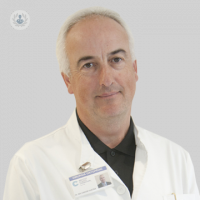Scoliosis Symptoms and treatment
Written by: What is degenerative scoliosis in adults?
Basically scoliosis is a deformity of the spine that produces an imbalance, a rotation, of the vertebral bodies , of the vertebrae of the spine. The best known is the scoliosis of the adolescent, which we have all known at some time for a child, for a family member, for a child of a friend who has a deviation of the back. Unlike the adolescent, in the adult, there are a series of characteristics that greatly aggravate this pathology that are basically the appearance of neurological symptoms , compressions, stenosis of the canal, compression of the nerves or the spinal cord. And also the presence of important degeneration of the intervertebral discs, what people usually call osteoarthritis of the vertebral discs. This makes the treatments that we have to apply in these patients are more complex and, above all, there is an added factor that basically also affects more female patients which is the presence of osteoporosis that also forces us to more complex treatments to ensure the stability of the assemblies that we do in these patients.
What symptoms does it have?
The most important symptoms that our patients present are of 2 types. One, the neurological symptoms, that is, the patient begins to notice the appearance of sciatica , of pain irradiated to the lower extremities, begins to present the inability to walk all that he would want , what we call claudication, that is, the patient wants to walk but the legs do not follow him and the presence of pains in the spine, this would be the initial group of symptoms. But afterwards there is also a group of very important symptoms related to stability , with the balance of our patients, patients realize that in a very short period of time they are beginning to present imbalances, they go to the side, they try to stay erect but fall either forward or sideways and these two symptoms, neurological and balance are the most important in patients with adult degenerative scoliosis.
How can it be treated?
The treatment is directed mainly to the two groups of symptoms that we have commented: the symptoms related to the loss of balance and the symptoms related to the neurological problems. For the loss of balance, unlike in the child, we can not use rigid corsets, we can not use orthotics because they atrophy the muscles and are not useful. What we should do is lose weight if we have a problem of obesity , improve the capacity of the muscles that support the spine, abdominal muscles, paravertebral muscles, what we should do is a physical activity adapted to our age and our situation. And for neurological symptoms what we should do is in addition to using some type of rehabilitative, electrotherapeutic treatments , etc.. We can end up needing medication through infiltrations sometimes in the epidural area, in the spine, in the spinal cord, to relieve the pain and neurological symptoms or what is called rhizolysis , facet blockages to relieve the pain of the spine vertebral
When should you opt for surgery?
Surgery is always the last resort and we should only use surgical treatments when the rest of possible treatments have failed. Basically, the surgery is aimed at solving the 2 basic problems presented by the patient. On the one hand the neurological problem, what we want is to decompress the nerves that are compressed so that the pains in the lower extremities will subside and so that the patient can recover the ability to walk without limit. And speaking of the second group of symptoms, what we want is to return to restore the balance that our patients have lost, either because they have fallen forward or because they have become unbalanced to one side and that is achieved through the use of reinforced titanium anchors. often with cement inside the body of the vertebrae to recover the static in this way, recover a good balance both in the frontal plane and in the sagittal plane .



